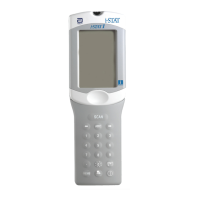10-2 Art: 714372-00L Rev. Date: 30-Jul-12
Hemolysis
Avoid hemolysis (bursting of red cells) by
• allowing residual alcohol to dry over the puncture site
• discarding a sample from a traumatic draw.
Hemolysis will cause an increase in potassium results and a decrease in
calcium results. For cTnI, CK-MB, and BNP cartridges, gross hemolysis
can also cause a decreased alkaline phosphatase activity and an increased
proteolytic activity, resulting in decreased detection of cTnI, CK-MB, or BNP.
VENIPUNCTURE - pH, PCO
2
, ELECTROLYTE, CHEMISTRY, AND HEMATOCRIT TESTS
Anticoagulants
If the sample can be tested in a cartridge immediately, a plain syringe can
be used. If a cartridge cannot be filled immediately the sample should be
collected in a blood collection tube with sodium heparin or lithium heparin or
a pre-heparinized syringe labeled for measurement of electrolytes and ionized
calcium (such syringes contain balanced or low-level heparin). If manually
heparinizing syringes, the heparin-to-blood ratio should not exceed 10 U
heparin per milliliter of blood. Blood collection tubes contain approximately 15
U/mL when filled to capacity.
Samples collected in EDTA anticoagulant may be used only with the i-
STAT Glucose and BNP cartridges. It may be convenient to collect a single
EDTA tube when testing for glucose and glycated hemoglobin (HbA1c)
simultaneously. EDTA may not be used with any cartridge type other than
the Glucose or BNP cartridges. EDTA will cause a clinically significant error
in sodium, potassium, chloride and hematocrit results and may affect other
chemistry tests. Do not use an EDTA sample with a cartridge that includes
glucose as part of a panel. Even if only the glucose result is to be used, all
results are stored in the analyzer’s memory and, since results can be printed
and transmitted to a Central Data Station, they can become part of the
patient’s permanent record.
i-STAT BNP cartridges require the use of EDTA whole blood or plasma
samples collected in plastic syringes or evacuated tubes containing EDTA.
The use of glass vessels is not recommended because the BNP molecule has
been shown to be unstable in glass tubes. The use of whole blood or plasma
samples containing other anticoagulants such as heparin, oxalate, and citrate
is not recommended.
Tube Order
Collect blood collection tubes in the prescribed sequence to avoid
interference due to carry-over of additive from one tube to the next:
• No additive
• Citrate
• Heparin
• EDTA - Na
2
, K
3
or K
2
• Oxalate, fluoride, iodoacetate
If a citrate tube is drawn, draw a 5mL plain discard tube before drawing the
heparin tube.

